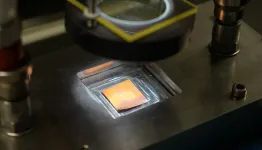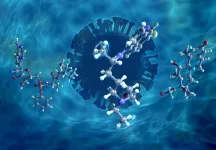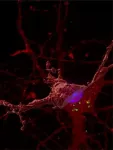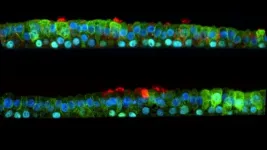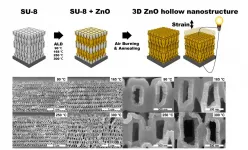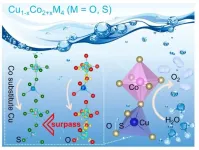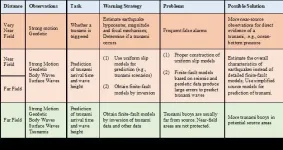(Press-News.org) Carbon dioxide (CO2) is one of the major greenhouse gases causing global warming. If carbon dioxide could be converted into energy, it would be killing two birds with one stone in addressing the environmental issues. A joint research team led by City University of Hong Kong (CityU) has developed a new photocatalyst which can produce methane fuel (CH4) selectively and effectively from carbon dioxide using sunlight. According to their research, the quantity of methane produced was almost doubled in the first 8 hours of the reaction process.
The research was led by Dr Ng Yun-hau, Associate Professor in the School of Energy and Environment (SEE), in collaboration with researchers from Australia, Malaysia and the United Kingdom. Their findings have been recently published in the scientific journal Angewandte Chemie, titled "Metal-Organic Frameworks Decorated Cuprous Oxide Nanowires for Long-lived Charges Applied in Selective Photocatalytic CO2 Reduction to CH4".
Nature-inspired photocatalysis
"Inspired by the photosynthesis in nature, carbon dioxide can now be converted effectively into methane fuel by our newly designed solar-powered catalyst, which will lower carbon emission. Furthermore, this new catalyst is made from copper-based materials, which is abundant and hence affordable," said Dr Ng.
He explained that it is thermodynamically challenging to convert carbon dioxide into methane using a photocatalyst because the chemical reduction process involves a simultaneous transfer of eight electrons. Carbon monoxide, which is harmful to human, is more commonly produced in the process because it requires the transfer of two electrons only.
He pointed out that cuprous oxide (Cu2O), a semiconducting material, has been applied as both photocatalyst and electrocatalyst to reduce carbon dioxide into other chemical products like carbon monoxide and methane in different studies. However, it faces several limitations in the reduction process, including its inferior stability and the non-selective reduction which causes the formation of an array of various products. Separation and purification of these products from the mixture can be highly challenging and this imposes technological barrier for large scale application. Furthermore, cuprous oxide can be easily corroded after brief illumination and evolve into metallic copper or copper oxide.
Selective production of pure methane
To overcome these challenges, Dr Ng and his team synthesised a novel photocatalyst by enwrapping cuprous oxide with copper-based metal-organic frameworks (MOFs). Using this new catalyst, the team could manipulate the transfer of electrons and selectively produce pure methane gas.
They discovered that when compared with cuprous oxide without MOF shell, cuprous oxide with MOF shell reduced carbon dioxide into methane stably under visible-light irradiation with an almost doubled yield. Also, cuprous oxide with MOF shell was more durable and the maximum carbon dioxide uptake was almost seven times of the bare cuprous oxide.
Carbon dioxide uptake increased
The team encapsulated the one-dimensional (1-D) cuprous oxide nanowires (with a diameter of about 400nm) with the copper-based MOF outer shell of about 300nm in thickness. This conformal coating of MOF on cuprous oxide would not block light-harvesting of the catalyst. Besides, MOF is a good carbon dioxide adsorbent. It provided considerable surface areas for carbon dioxide adsorption and reduction. As it was closely attached to the cuprous oxide, it brought a higher concentration of carbon dioxide adsorbed at locations near the catalytic active sites, strengthening the interaction between carbon dioxide and the catalyst.
Moreover, the team discovered that the cuprous oxide was stabilised by the conformal coating of MOF. The excited charges in cuprous oxide upon illumination could efficiently migrate to the MOF. In this way, excessive accumulation of excited charges within the catalyst which could lead to self-corrosion was avoided, hence extended the catalyst's lifetime.
Electrons stayed in MOF with higher chance of having chemical reactions
Dr Wu Hao, the first author of the paper who is also from SEE, pointed out one of the highlights of this research and said: "By using the advanced time-resolved photoluminescence spectroscopy, we observed that once the electrons were excited to the conduction band of the cuprous oxide, they would be directly transferred to the lowest unoccupied molecular orbital (LUMO) of the MOF and stayed there, but did not return quickly to their valence band, which is of lower energy. This created a long-lived charge separated state. Therefore, electrons that stayed in the MOF would have a higher chance to undergo chemical reactions."
Extends the understanding of relationships between MOFs and metal oxides
Previously, it was generally believed that the improved photocatalytic activities were merely induced by MOF's reactant concentration effect and MOF only served as a reactant adsorbent. However, Dr Ng's team unveiled how the excited charges migrate between cuprous oxide and MOF in this research. "MOF is proven to play a more significant role in shaping the reaction mechanism as it changes the electron pathway," he said. He pointed out that this discovery has extended the understanding of relationships between MOFs and metal oxides beyond their conventional physical/chemical adsorption type of interactions to facilitating charge separation.
The team has spent more than two years to develop this effective strategy in converting carbon dioxide. Their next step will be to further increase the methane production rate and explore ways to scale up both the synthesis of the catalyst and the reactor systems. "In the entire process of converting carbon dioxide to methane, the only energy input we have used was sunlight. We hope in the future, carbon dioxide emitted from factories and transportation can be 'recycled' to produce green fuels," concluded Dr Ng.
INFORMATION:
Dr Ng is the corresponding author of the paper and the first author is Dr Wu Hao. Other collaborating researchers are from University College London, University of New South Wales, Monash University in Malaysia, and the Swinburne University of Technology.
The research was funded by CityU, Hong Kong Research Grant Council and the Australian Research Council.
https://www.cityu.edu.hk/research/stories/2021/01/28/novel-photocatalyst-effectively-turns-carbon-dioxide-methane-fuel-light
King Richard III's involvement in one of the most notorious and emotive mysteries in English history may be a step closer to being confirmed following a new study by Professor Tim Thornton of the University of Huddersfield.
Richard has long been held responsible of the murder of his nephews King Edward V and his brother, Richard, duke of York - dubbed 'the Princes in the Tower' - in a dispute about succession to the throne. The pair were held in the Tower of London, but disappeared from public view in 1483 with Richard taking the blame following his death two years later.
It has become of the most ...
In the United States only about 1.3 percent of all vehicles sold last year were battery powered. And about 90 percent of those sales were by one company -- Tesla. What has Tesla done right and where have other electric vehicle makers gone wrong?
Electric vehicles cannot succeed without developing a nationwide network of fast-charging networks in parallel with the cars. Current EV business models are doomed unless manufacturers that have bet their futures on them, like General Motors and VW, invest in or coordinate on a robust supercharger network. These are the observations in an in-depth study of the industry by management professors at the University of California, Davis, and Dartmouth College.
The researchers explain that big ...
As the scientific community continues researching the novel coronavirus, experts are developing new drugs and repurposing existing ones in hopes of identifying promising candidates for treating symptoms of COVID-19.
Scientists can analyze the molecular dynamics of drug molecules to better understand their interactions with target proteins in human cells and their potential for treating certain diseases. Many studies examine drug molecules in their dry, powder form, but less is known about how such molecules behave in a hydrated environment, which is characteristic of human cells.
Using neutron experiments and computer ...
University of Queensland researchers have discovered a new 'seeding' process in brain cells that could be a cause of dementia and Alzheimer's disease.
UQ's Queensland Brain Institute dementia researcher Professor Jürgen Götz said the study revealed that tangled neurons, a hallmark sign of dementia, form in part by a cellular process that has gone astray and allows a toxic protein, tau, to leak into healthy brain cells.
"These leaks create a damaging seeding process that causes tau tangles and ultimately lead to memory loss and other impairments," Professor Götz said.
Professor Götz said until now researchers did not understand how tau seeds were able to escape after ...
Research into a new drug which primes the immune system in the respiratory tract and is in development for COVID-19 shows it is also effective against rhinovirus. Rhinovirus is the most common respiratory virus, the main cause of the common cold and is responsible for exacerbations of chronic respiratory diseases such as asthma and chronic obstructive pulmonary disease. In a study recently published in the European Respiratory Journal (LINK), the drug, known as INNA-X, is shown to be effective in a pre-clinical infection model and in human airway cells.
Treatment with INNA-X prior to infection with rhinovirus significantly reduced viral load and inhibited harmful inflammation.
University of Newcastle and Hunter Medical Research Institute (HMRI) researcher Associate Professor ...
With the importance of non-contact environments growing due to COVID-19, tactile electronic devices using haptic technology are gaining traction as new mediums of communication.
Haptic technology is being applied in a wide array of fields such as robotics or interactive displays. haptic gloves are being used for augmented information communication technology. Efficient piezoelectric materials that can convert various mechanical stimuli into electrical signals and vice versa are a prerequisite for advancing high-performing haptic technology.
A research team led by Professor Seungbum Hong confirmed the potential of tactile devices by developing ceramic piezoelectric materials that are three times more deformable. For the fabrication of highly deformable nanomaterials, the ...
A recent study from Oregon State University has found that to best help kids with autism maintain healthy rates of physical activity, interventions should be targeted during the ages of 9 to 13, as that's when kids show the biggest drop in active time.
The study is one of the first to look at this issue on a longitudinal scale. It relied on a dataset of families in Ireland spanning three in-depth interviews between 2007 and 2016. Kids in the survey had their first interview at age 9, the second at 13 and the third at 17 or 18.
The OSU study compared 88 children with autism to 88 children without autism over the nine-year survey period to gauge both how physical activity changed over time, and how much ...
Oxygen evolution reaction (OER), as a vital half-reaction in some clean energy storage and conversion technologies including rechargeable metal-air batteries, regenerative fuel cells and electrochemical water splitting, has been of crucial importance for exploring highly efficient sustainable energy to substitute exhaustible fossil fuels. Among them, electrochemical water splitting can effectively produce clean and reproducible hydrogen fuels through renewable energy sources as power input like solar energy, etc. Unfortunately, the efficiency of water splitting is mainly impeded by the high anodic overpotential of OER, in which seeking efficient and stable electrocatalysts is highly desirable. It has been considered that spinel-structure materials can be meaningful alternative catalysts ...
Tsunamis are one of the most destructive disasters in the ocean. Large tsunamis are mostly generated by earthquakes, and they can propagate across the ocean without significantly losing energy. During the shoaling process in coastal areas, the wave amplitude increases dramatically, causing severe life loss and property damage. There have been frequent tsunamis since the 21st century, drawing the attention of many countries on the study of tsunami mechanism and warning. Tsunami records also play an essential role in deriving earthquake rupture models in subduction zones.
A recent paper entitled "Tsunamis and tsunami warning: recent progress and future prospects" by Dr. Chao An from Shanghai Jiao Tong University reviews the recent research progress of earthquake-generated ...
Sedative medications used in intensive care are associated with increased delirium, which is in turn connected with higher medical costs and greater risk of death and ICU-related dementia.
A study published today in the New England Journal of Medicine provides the most definitive evidence to date that, of the two drugs recommended for light sedation of patients receiving mechanical ventilation in the ICU, one is as effective and safe as the other.
Mechanical ventilation is a life-saving intervention often involving a breathing tube inserted in the patient's windpipe, typically entailing light sedation to quell the attendant discomfort, anxiety and psychological stress. Several studies have sought evidence of which ...
